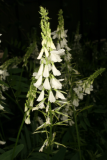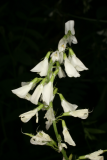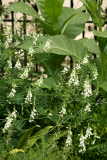Additional notes (click to expand)
Medicinal
Prescription only medicine: Metformin
Culpeper: ‘... resists poison, kills worms, resists the falling sickness, resisteth the pestilence.’
Culpeper, Nicholas. (1650). A Physical Directory . London, Peter Cole.
"Galegine was isolated as an active anti-hyperglycaemic agent [from this plant] ... provided the template for the synthesis of metformin" This is an important medicine in the management of Type 2 diabetes.
Fabricant, D S and Farnsworth, N R. (2001) 'The value of drugs used in Traditional Medicine for Drug Discovery'. Environmental Health Perspectives 109:suppl 1: 69-75
Galega officinalis L. Goat's Rue. Distribution: Central and Southern Europe, Asia Minor. Goat’s Rue – C & S Europe, Asia Minor. Culpeper (1650) writes that it ‘... resists poison, kills worms, resists the falling sickness [epilepsy], resisteth the pestilence.’ Galega officinalis contains guanidine which reduces blood sugar by decreasing insulin resistance and inhibiting hepatic gluconeogenesis.. Metformin and Phenformin are drugs for type II diabetes that rely on this group of chemicals, known as biguanidines.
Oakeley, Dr. Henry F. (2013). Wellcome Library notes.
link
Nomenclature
Family name changed from Papilionaceae to Fabaceae. Name reverted to Galega officinalis .
Plants of the World online, Kew Science http://plantsoftheworldonline.org/taxon/urn:lsid:ipni.org:names:495681-1
link
Other use
Its name gala, meaning milk plus ega meaning 'to bring on', refers to its alleged property of increasing milk yield, and has been used in France to increase milk yield in cows. 'Officinalis' refers to its use in the offices of the monks, and is a common specific name for medicinal plants before 1600 and adopted by Linnaeus (1753). The fresh plant tastes of pea pods.
Geographical distribution
- Africa
- Asia-Temperate
- Asia-Tropical, Indian Subcontinent, Pakistan
- Europe
Galega officinalis L. f. alba
Family: FABACEAEGenus: Galega
Species: officinalis L.
Form: alba
Common names: Goat's rue 'Alba'
Pharmacopoeia Londinensis name: Galega/Ruta capraria
Distribution summary: C. & S. Europe, Asia, N. Africa
Habit: Perennial
Hardiness: H4 - Hardy; average winter
Habitat: Dry grassland, scrub, meadows, open woodland, roadsides
Garden status: Not currently grown
Flowering months: June, July
Reason for growing: Medicinal, other use, prescription only medicine
.JPG)
.JPG)

.JPG)
.JPG)


